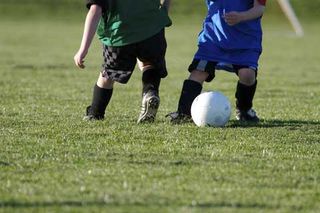Exercise Improves Kids' Academics

The end of 2008 brings some discouraging news about our kids' brains and brawn. Recent results from an international math and science test show United States students are performing near the middle of the pack compared to other countries, while their levels of obesity continue to climb.
Historically, these two trends were studied independently with plans of action developed for each. However, several researchers and a new book have been making the case for linking these two problems by showing the effects of aerobic exercise not only on a student's fitness level but also on their test scores.
Earlier this month, the latest (2007) TIMSS (Trends in International Mathematics and Science Study) scores were released. They compare fourth grade students from 36 countries and eighth grade students from 48 countries. They were tested on subjects that were common to all of the countries, including algebra, geometry, chemistry and physics. Overall, 425,000 students participated in the test, which is administered every four years.
In math, American fourth graders came in at 11th place of the 36 countries while eighth graders scored ninth out of 48. Hong Kong and Taiwan ranked first for fourth grade and eighth grade, respectively. In science, Singapore topped the list for both fourth grade and eighth grade, with U.S. science students taking eighth place and 11th place.
While the American math scores have improved slightly, the science scores have dropped. In 2003, U.S. fourth graders were in sixth place in the world and eighth graders were in ninth place. Only 6 percent of U.S. eighth-grade students reached the TIMSS "advanced" level in math, compared to 45 percent of students in Chinese Taipei, 40 percent in Korea, 40 percent in Singapore, 31 percent in Hong Kong, 26 percent in Japan and 10 percent in Hungary.
Regarding student fitness, the most recent figures from the Centers for Disease Control and Prevention report that the percentage of overweight or obese 6- to 11-year-olds has tripled since 1980, with more than 125 million children at unhealthy levels.
Leaping backward
Sign up for the Live Science daily newsletter now
Get the world’s most fascinating discoveries delivered straight to your inbox.
Ironically, one of the solutions proposed for raising test scores, the federal No Child Left Behind program, encourages schools to focus more of the school day on the core academic subjects while reducing class time in peripheral subjects, like art, music, and physical education. In fact, only 6 percent of American high schools offer a daily gym class. Yet a 2002 Virginia Tech study showed no relationship between reduced class time in those subjects and higher overall standardized tests.
In his latest book, "Spark: The Revolutionary New Science of Exercise and the Brain" (2008, Little, Brown), John Ratey, a Harvard clinical associate professor of psychiatry, argues for more physical fitness for students as a cure for not only their obesity but also their academic performance.
"I cannot underestimate how important regular exercise is in improving the function and performance of the brain." Ratey writes. "Exercise stimulates our gray matter to produce Miracle-Gro for the brain." That "Miracle-Gro" is a brain chemical called brain-derived neurotropic factor, or BDNF. When we exercise, our working muscles send chemicals into our bloodstream, including a protein known as IGF-1.
Once in the brain, IGF-1 orders the production of more BDNF. The additional BDNF helps new neurons and their connections grow. In addition, levels of other neurotransmitters are increased after a strenuous exercise session.
"Dopamine, serotonin, norepinephrine — all of these are elevated after exercise," says Ratey. "So having a workout will help focus, calming down, and impulsivity — it's like taking a little bit of Prozac and a little bit of Ritalin."
Evidence mounts
Research showing a link between fitness and academics is growing.
The California Department of Education (CDE) looked for a correlation between fitness scores and test scores. They found that kids who were deemed fit (by a standard test of aerobic capacity, BMI, abdominal strength, trunk strength, upper body strength and overall flexibility) scored twice as well on academic tests as those that were unfit. In the second year of the study, socio-economic status was taken into account, to possibly eliminate that variable as an explanation. As expected, those in the upper-income brackets scored better overall on the academic tests, but within the lower-income set of students, the same results were observed — kids who were more fit performed better academically.
Charles Hillman, associate professor of kinesiology at the University of Illinois, was able to duplicate these findings with 259 third and fifth-grade Illinois students. His team also noticed that two of the tests, BMI and aerobic capacity, were significantly more influential to higher academic scores than the other four fitness factors. Digging deeper, he isolated two groups of 20 students, one fit and the other unfit. They were given cognitive tests of attention, working memory and processing speed while their brain's electrical activity was being measured by an electroencephalogram (EEG) test.
The fit kids' brains showed more activity in the prefrontal cortex, known for its executive function and control over other brain processes.
So, just send the kids on a fast jog and they will ace all of their tests? Not quite.
“The exercise itself doesn't make you smarter, but it puts the brain of the learners in the optimal position for them to learn,” Ratey said. “There's no way to say for sure that improves learning capacity for kids, but it certainly seems to correlate to that."
- How to Pick Athletic Superstars at Age 1
- Bad Sports Behavior Starts in Youth
- 5 Ways to Beef Up Your Brain
Dan Peterson blogs about sports science at his site Sports Are 80 Percent Mental and at Scientific Blogging.
Most Popular


